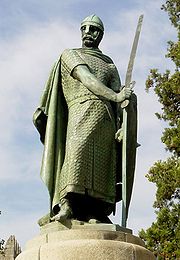
António Soares dos Reis
Encyclopedia

Vila Nova de Gaia
Vila Nova de Gaia, or simply Gaia is a city in Vila Nova de Gaia Municipality, Portugal. It is located in the Porto District, south of the city of Porto on the other side of the Douro River. The city proper has a population of 178,255 and the municipality contains 24 parishes with a total...
, 14 October 1847 - Vila Nova de Gaia
Vila Nova de Gaia
Vila Nova de Gaia, or simply Gaia is a city in Vila Nova de Gaia Municipality, Portugal. It is located in the Porto District, south of the city of Porto on the other side of the Douro River. The city proper has a population of 178,255 and the municipality contains 24 parishes with a total...
, 16 February 1889) was a Portuguese sculptor.
Studies
He first studied at the Portuense Academy of Fine Arts, where he graduated in sculpture in 1867. He studied at the Fine Arts Imperial School of ParisParis
Paris is the capital and largest city in France, situated on the river Seine, in northern France, at the heart of the Île-de-France region...
, from 1867 to 1870, where he achieved several prizes, and in Rome
Rome
Rome is the capital of Italy and the country's largest and most populated city and comune, with over 2.7 million residents in . The city is located in the central-western portion of the Italian Peninsula, on the Tiber River within the Lazio region of Italy.Rome's history spans two and a half...
(1871-1872). It was there that he executed his finest work, in Carrara marble
Carrara
Carrara is a city and comune in the province of Massa-Carrara , notable for the white or blue-grey marble quarried there. It is on the Carrione River, some west-northwest of Florence....
, the acclaimed "O Desterrado" ("The Exiled"), a touching image of neoclassical, romantic and realist resemblances, that is the masterpiece of Portuguese sculpture.
After returning to Portugal, he returned to Porto
Porto
Porto , also known as Oporto in English, is the second largest city in Portugal and one of the major urban areas in the Iberian Peninsula. Its administrative limits include a population of 237,559 inhabitants distributed within 15 civil parishes...
, where he taught at the Portuense Academy of Fine Arts.
Misunderstood and little credited in life, he committed suicide, aged only 41. He is considered, by far, one of the leading names in Portuguese realist
Realism (visual arts)
Realism in the visual arts is a style that depicts the actuality of what the eyes can see. The term is used in different senses in art history; it may mean the same as illusionism, the representation of subjects with visual mimesis or verisimilitude, or may mean an emphasis on the actuality of...
sculpture
Sculpture
Sculpture is three-dimensional artwork created by shaping or combining hard materials—typically stone such as marble—or metal, glass, or wood. Softer materials can also be used, such as clay, textiles, plastics, polymers and softer metals...
.
Fame
The finest collection of his pieces is shown in a room dedicated to him at the National Museum Soares dos ReisNational Museum Soares dos Reis
National Museum Soares dos Reis , located in the ancient Carrancas Palace, in Porto, Portugal, is one of the most renowned Portuguese museums.The museum Soares dos Reis, founded in 1833, is Portugal's first national museum...
, in Porto, including "O Desterrado" and the touching and kind figuration of the "Count of Ferreira" (1876).

